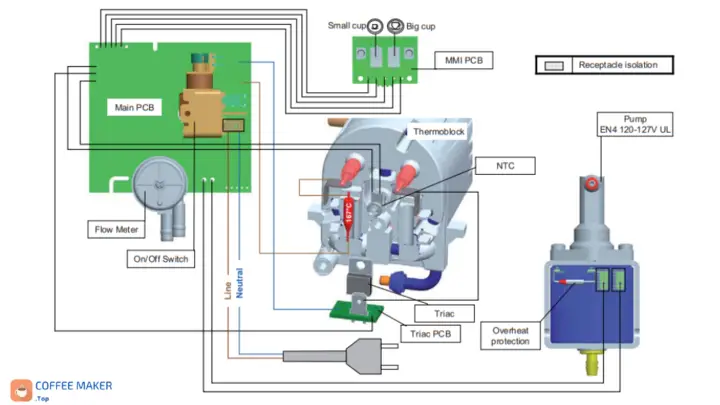Even though there is no exact defined measure to prepare a perfect espresso, there is a generalized consensus that certain criteria should be maintained when preparing this ideal coffee. These are the following:
- Quantity of ground coffee: 7 grams
- Type of grind: Relatively fine
- The temperature of infusion: 86 degrees Celsius
- The temperature of the coffee in the cup: 71 degrees Celsius
- Preparation time: 5 seconds of pre-infusion and 25 seconds of infusion.
- The final volume of coffee extracted: 25 millilitres
If any of these values is altered too much, the coffee obtained will be far from being a good espresso coffee. We should pay close attention to the temperature when our Nespresso coffee machine prepares the coffee and intervene if the temperature drops too much.
Thermoblock or thermostat failure
Suppose a fault occurs in the thermoblock or the thermostat of the Nespresso coffee machine, and it detects it. In that case, the espresso button and the lungo button lights will start flashing with three flashes every 2 seconds.
As we saw in the article dedicated to the meaning of the lights on Nespresso machines, the machine enters the failure mode and inhibits the user from preparing any coffee. Therefore, and in theory, if there is a fault in the thermostat or thermoblock, you will not notice any change in the temperature of the coffee because you will not be able to prepare it.

However, before one of these two components fails definitively and the coffee maker detects the problem, we may begin to feel a lower temperature in our coffees. The moment we detect the less (sometimes more) temperature in the beverage obtained from our Nespresso is the best time to act since we will avoid major problems.
Whenever the coffee temperature drops below 83ºC during the preparation of the coffee, one or more decalcifications should be carried out since the accumulation of limescale is the main cause of the low temperature of the final coffee.
How does the thermoblock and thermostat of a Nespresso coffee machine work?
A standard thermoblock of a Nespresso coffee machine can heat up to 105ºC, this being its maximum capacity by design. However, it works at about 86ºC under normal conditions since the thermostat connected in series opens and closes the circuit at 83 and 89 degrees Celsius.
To check that a thermostat is working, you should do a continuity test with the coffee maker turned off; if there is continuity, the thermostat is working. Although on rare occasions, it could give continuity and operate at an incorrect temperature range.
Conclusion
Any failure of the thermoblock or thermostat will be detected and warned by the coffee maker, making coffee preparation impossible. Thus, in practically all cases, a lack of temperature in the preparation of coffee will be due to an accumulation of limescale on the internal walls of the thermoblock.
If, after several decalcifications, the problem is not solved, it is advisable to replace the thermoblock and the thermostat. The bad news is that acquiring a new thermoblock could be expensive (it can cost up to £35), and it is not easy to find.
